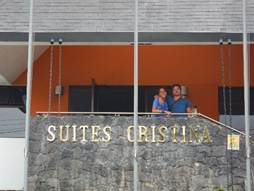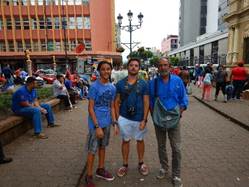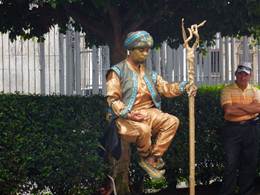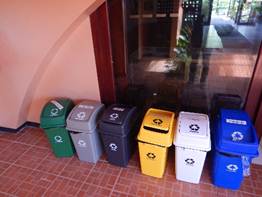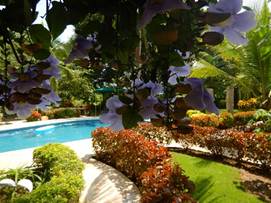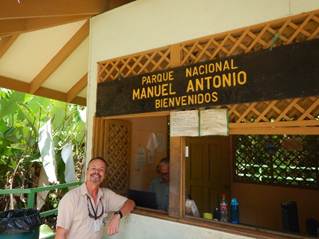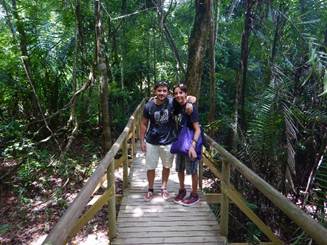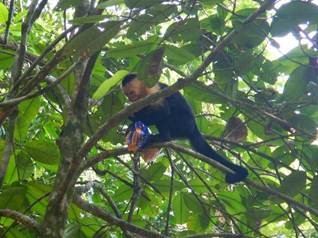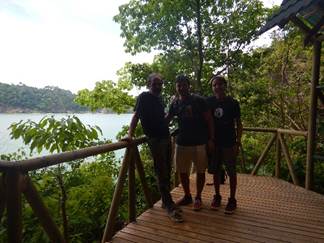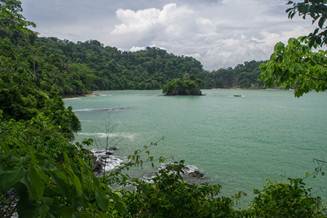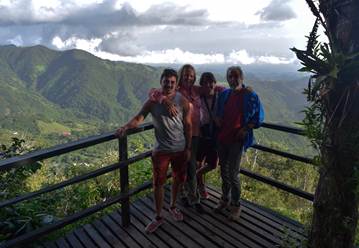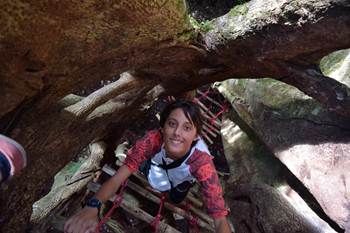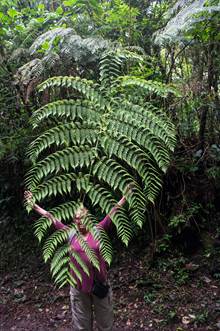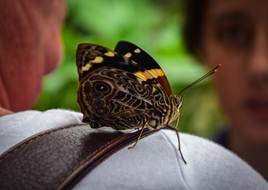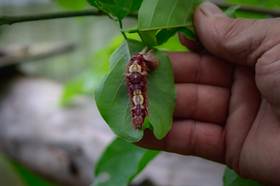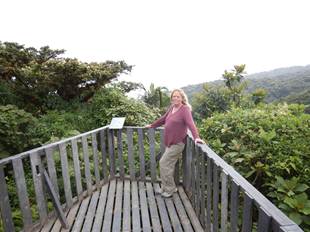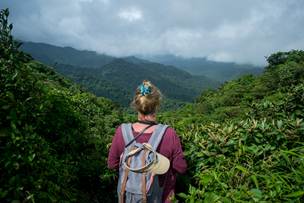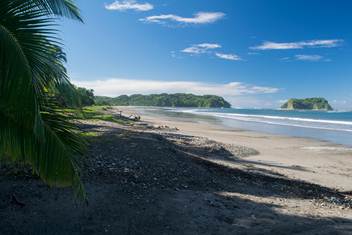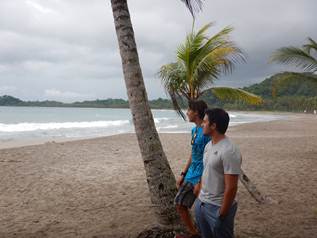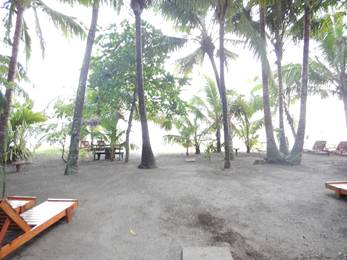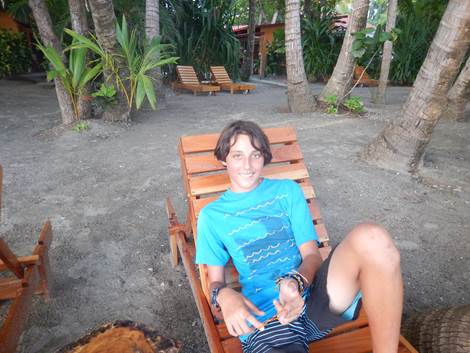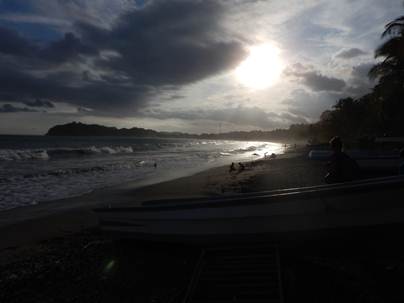Blog Post 43 - Costa Rica Road Trip

Blog Post 43 – Costa Rica Road Trip 6/18/16 – 06/26/16 When we were considering our options for travel to Costa Rica, we looked into taking the bus as well as flying. Many people here do not own cars and travel by bus. There are 3 levels of buses, the Premium Class where you have an air conditioned bus with reclining seats, a direct route with no stops, wifi, a hostess and clean bathrooms, then there is Regular Class which is basically the milk run that takes 36 hours and makes stops everywhere along the way. The middle class falls somewhere in between. Even with the direct premium class bus it still took 16 hours. Daniel and I were trying to plan this trip so as to not break the budget. We had not planned on taking this trip so we wanted to do our best to keep the expenses down. The premium class RT ticket was $165. When we checked into flights we found one that was direct from San Salvador to San Jose, RT for only $198. As far as we were concerned there was no comparison, we would be flying. The airports in Central America are pretty decent. They are small and usually crowded, but you can get everything you need. The San Salvador airport is no different. Daniel and I actually spent 14 hours in this airport during an unexpected delay 10 years ago when we were on our way to Peru, so we are intimately familiar with it. The flight was uneventful, which is always good, the scenery was spectacular. We flew over Lake Nicaragua which is the largest body of water in Central America and then flew down the coast of Costa Rica and cut in to San Jose, the capital. Jirig was not thrilled at all about taking this trip. He is not a tourist by any stretch of the imagination and he hates to leave the boat. Not only was he leaving the boat but he was letting workers do varnishing and carpentry work on the boat while we were gone. That is unheard of. He saw this trip as one big money pit. We were going to do our best to make sure that did not happen. Daniel, Nico and I however were thrilled and could not wait to get there. We knew he would come around once we got there and he saw the place. Daniel has been to Costa Rica before, so he assumed the role as our guide as to what to see and do. He had used Air BnB when he was there and said it was great, so we did that. I had always wanted to try them. We booked all the places we stayed thru them and were not disappointed. The way the hotels are set up in CR all rates are based on a 2 person occupancy. Each additional person is 30% of the rate more per person. The idea of spending 8 days sharing a hotel room with our grown and almost grown sons was not appealing. We are basically traveling as 4 adults. They are as big as adults and eat like them too! I knew that if we did not have separate rooms where everyone could have their own space, we would be miserable. We booked entire homes and condos, fully furnished and equipped for an average of $60 per night. The most we ever paid for one was $100 and that was in San Jose. For us it was a score. Saved us a ton of money. I will forever be an advocate. The plan was to spend the night in San Jose, check out the town and then head south to Queppos. We had rented a car, a large SUV so we would be comfortable for about $45 per day. We would be covering a lot of miles on this trip. We had not travelled together, off of the boat, as a family in a few years, since we went to Kauai. It took a little adjustment. Our kids are 23 and 13. Daniel wants to take charge now. He wants to decide where we are going, what we are doing, where we are going to stay and then he wants to drive on top of it. That does not sit well with Jirig. You can’t have 2 control freaks in the same car. Nico on the other hand isn't a little kid anymore. He is 13 and he definitely has an opinion….on everything. He wants to sit in the front seat, wants to turn off the AC, wants to keep his window open all the time, doesn't like the music we are playing etc. It would take us a couple of days to get into the family groove of road travel again. We picked up the car and the Bickersons made their way to the AirBnB rental. It was really nice. It was 2 BR 2 Bath condo with fully equipped kitchen, with an expresso machine no less and it included breakfast! It was part of a beautifully landscaped property with a pool, Jacuzzi and weight room. It was located across the street from San Jose’s version of Central Park. San Jose is a large, sophisticated city, by Central American standards. It is prosperous and diverse. There were tons of food and shopping options. We found a Johnny Rockets and scarfed down some burgers, fries and shakes, much to our delight. We made it an early night as we planned on getting on the road first thing in the morning.
The ride to Queppos through the Costa Rican countryside was gorgeous. Rolling hills interspersed with lush jungle. Mountains and valleys and volcanoes in the distance. One of the first things we noticed about Costa Rica was how clean it was. There is no trash, none whatsoever, anywhere. That is a huge difference from what you see in Mexico, El Salvador and Guatemala. No plastic of any kind on the road. It was amazing. There are recycle bins everywhere. And not just one or two; they have you separating your garbage into 6 categories.
The reason we were headed to Queppos, which is about 135 miles from San Jose, was to visit Manuel Antonio National Park. Daniel had been there with his girlfriend the year before and just raved about it. Manuel Antonio National Park, on Costa Rica’s central Pacific coast, encompasses rugged rainforest, white-sand beaches and coral reefs. It’s renowned for its vast diversity of tropical plants and wildlife, from three-toed sloths and endangered white-faced capuchin monkeys to hundreds of bird species. The park’s roughly 680 hectares are crossed with hiking trails, which meander from the coast up into the mountains. It is unique as it is has lush jungle but it sits right on the rocky shores of the Pacific. On the downside, it is a very popular place to visit. We were there in the off season and it was mobbed, we were accosted by vendors and hawkers a full 1 kilometer from the park. We had gotten there late, around mid-day and they were about to close the park because there were too many people inside. Had we to do it over again, we definitely would have done it first thing in the morning. Even though it was crowded, it was beautiful. The trails were set up on wooden platforms above the ground so it was very easy going. There was wildlife everywhere. We saw sloths, raccoons, monkeys, butterflies, frogs, bugs and more bugs and things I did not even know what they were. It was a beautiful hike, it was shady under the canopy and the trails wound around along the coast. The howler monkeys are very mischievous. There is a popular spot along the trail to stop and swim at the beach. People leave their backpacks and clothes on the beach while they swim. The opportunist monkeys go through their things looking for goodies. We saw a monkey unzip someone's back pack and take out a bag of hot dog buns. He promptly zipped the bag bag up and scrambled into the trees. Then he did a spectacular thing. He did not run away like a dog or a seagull would. He deftly opened the bag and tore off one bun at a time, at just the correct place and gave one to each of his buddies! They were sharing the booty and fairly at that. Clearly they had done this before. Again the AirBnB we booked was perfect. A very large 2 BR 2 BA condo and on a nice remote property just outside of town. We went into town to pick up dinner at the local falafel place and proceeded have one of the best falafel dinners ever. Go figure. We brought the food back to the condo so we could watch the finals of the Copa America soccer tournament. Argentina was playing and the family was not about to miss Lionel Messi. The game and a six pack of good local beer and we were set for the night.
The town of Queppos in a funky little place with health food restaurants, yoga studios and sushi and falafel restaurants. But do not be fooled by its funkiness. Here we started to experience the sticker shock that is Costa Rica. We felt like an ATM machine just shelling out the cash. You had to pay for parking at the park $5, then an expensive entrance fee of $16 per person. Every meal we had, whether it be pizza or burgers was a minimum of $50 for the 4 of us. And that was without alcohol. If we had drinks etc we did not get out of a restaurant for less than $100. The food is not that even that great. Everything is expensive there. Food, gas and just seeing the sights. There are tour companies and guides everywhere. They really discourage you from traveling on your own. It is difficult to get information on tourist sights and national parks, trails and maps etc as they want to control everything you do but…. for a hefty price. We are not tour type of people and rarely will we hire a personal guide. But it was not an easy thing to do. They want you to take a tour everywhere. Ask a local where the waterfall is and he will tell you he will guide you there….for a price. We found most tourists did not even rent a car but saw the country exclusively by tour bus. Not for us. The next day we made the 150 mile schlep up to the mountains to the Monte Verde Cloud Forrest. Again it was a spectacular drive through the Costa Rican countryside. That is until we hit the mountains. The last 15 miles of the road was not paved. It had deep ruts in it with big holes and boulders strewn everywhere. It does not sound like a long way, 15 miles, but it is, on a dirt road. It took a good 1 ½ hours. The roads in Costa Rica suck, there is no other way to say it. They are not well maintained, are usually only 1 lane in either direction or you only travel as fast as the slowest car in front of you. There are few shoulders, passing lanes or guard rails. The signs are poorly marked. The only way we were able to successfully navigate was by using Google Maps and a new app called Maps.me. For various reasons just using one did not work, you had o use a combination of the two apps. The role of navigator was an important one, one person navigates and the other drives. If you want to sit in the front seat, which is still an ongoing battle in our car. You have to pay attention and provide some skills. The drive through the Central Valley of Costa Rica really gives you a sense of the lushness, abundance and tranquility here. There are farms everywhere, working cattle ranches and tiny hamlets. We saw more shades of green that we ever thought possible.
The Monte Verde Cloud forest is right next to the little town of Santa Elena. It is a rustic little mountain town filled with gringoes of varying degrees. Like in Queppos there were high end resorts for $300 per night and they were hostels for $10 per night. There were some good food options of a decent variety. We had reserved a cabin through AirBnB. The cabin was outside of town, just 2 blocks from the cloud forest. The 2 KM road to town from the cabin was atrocious. We were stunned that with all these tourist buses coming through and all the money that was coming in why they did not improve access to this place? Therein lies the problem with the tourist dollars pouring into Costa Rica. There are a few top tour companies that dominate the market. All are foreign owned and most of the money collected leaves the country and most certainly does not trickle down to the local population. Costa Rica is a robust, well oiled tourist machine. It is their number one source of revenue and they milk it for every last drop. They should try reinvesting some of it into the communities they are reaping it from. It gave us a whole new perspective on hiring local guides. Wherever we could, we avoided the big tour companies and used local guides and services. Our cabin was a large, sparsely furnished 2 BR 3 BA place set far off the road on a private 16 acre farm. The property was spectacular. If we thought the road from town was bad, the road to the cabin was atrocious. There were six rental houses on the property but none could be seen from the other. The owners had built trails throughout the property and provided free guided tours through it both day and night, our guide and next door neighbor, Dulce, was also our AirBnB host. She was amazing. She came here as a child with her 10 siblings, her parents were missionaries. She was a veritable wealth of information and was so passionate about the cloud forest and protecting it. She took us on a hike through the property and showed us things that blew our minds. One of which was me standing within 2 feet from the most poisonous snake in Costa Rica. You could not even see it was so well camouflaged. I almost sat on it! Overall what struck me most about CR was its lushness, its diversity, the vast assortment of animals an insects but most of all it was the trees. There are over 400 species of trees in CR. One of the most spectacular is the fig tree. I never thought much about them before but now I have a new appreciation for them. They are the bedrock of the cloud forest. They are a whole ecosystem unto themselves. While we were there we took a tour through a butterfly sanctuary. I have always been fascinated by butterflies and CR has the most amazing ones I have ever seen. As it turns out, all butterflies have a host plant that they feed and breed on. They have camouflage capabilities that match their host plants. We went through these enclosed sanctuaries where the butterflies lived in all their various stages of development were flying and crawling around. It was so cool.
By our third day there Jirig and Nico were done with hiking. Over the previous 3 days we had put in a good 15 miles of hiking and walking and they were over it. Cloud forest or not they were staying put. Daniel and I planned an afternoon of hiking in the cloud forest and Jirig and Nico kicked back at the cabin. It was a nice opportunity for Daniel and me to spend some much needed mom and son alone time together. We walked and talked and talked and walked and took in the spectacular surroundings. It was much less crowded up here then down by the coast and it was nice to be alone on the trails for once. I would love to come back here and spend a month or two. There is so much to see and do. Just to sit in the forest alone and meditate would be awesome.
We had four more days of our trip and we wanted to spend it at the beach just kicking back. We purposely did not book anything for these 4 days because we wanted to be able to make a decision based on what we had seen and what we wanted to do more of. We considered going to CR’s Caribbean coast, there are much better beaches there but it was far, a good 11 hours by car. That would mean 2 solid days in the car getting there and back and that killed it. We were over the car and just wanted to relax. We headed for the Nicoya coast. We had heard it had the best beaches on the Pacific coast. Enter the surfer and hippie haven that is Samarra. It is a spectacular beach town, full of surfers and hippies, yogis and herbalists. There are surf schools, language schools and cooking schools. We found a nice little beach cottage just outside of town. It was called the Fenix. I would highly recommend it. It is far enough away from town so you don't hear the partying and the music but close enough to be a ten minute walk down the beach. The cabin was small, just 1BR, 1BA and a small kitchen. The kids slept on a pullout couch in the living room. We were in heaven. We had missed the beach and the water so much! Where the boat is located in El Salvador, is in an estuary. The water is dark and murky and the current is fast. It does not lend itself to swimming, diving and snorkeling like we are used to. The Pacific coast of ES is rough and dangerous, not good for swimming. The little bay the town of Samarra sits in is protected on both ends by rocks and reefs jutting out to the sea. The bay is calm and the waves reasonable. The water is warm and clear. We played on the beach and counted our blessings for finding this little slice of paradise. That was until the sun went down……with the night came all the things that fly and crawl. The beach and the property we were staying at literally was crawling with life. There were huge iguanas, lizards, snakes, rats, raccoons, possums. There were thousands and thousands of hermit crabs, their little shells scuttling across the ground. There were mosquitos, wasps the size of your hand, bees, cockroaches like you have never seen before and spiders, lots of spiders. That first evening we had a huge iguana come in the room and reside on top of the air conditioner. There were hermit crabs, regular crabs and cockroaches crawling under the crack in the door, there were mosquitoes buzzing your head and no see ums biting you out of nowhere. Oh did I forget the ants? They had large ants, minuscule ants that could crawl through the smallest openings, fire ants that bit you as soon as they crawled on you. Ok this is CR, I get it. We are staying where the jungle meets the sea. We should be tolerant of these things that crawl and try to cohabitate with them right? Hell no! After that first night we tried to locate and plug up all the holes and access points to the cabin. We sprayed Raid along the door and window jams. It helped a little. But there is just no escaping it; there are creepy crawlers everywhere in CR!
The Costa Rican culture was an enigma to us. We were hard pressed to figure it out. We saw many amazing things here that were found nowhere else in Central America. As I said before there is no litter anywhere. They recycle everything. You can drink the water from the tap everywhere. The entire country is non-smoking. By 2020 Costa Rica’s goal is to be using 100% sustainable energy and be carbon neutral. People here do not smoke. They are fit. You see people working out, running, biking and there are gyms everywhere. Their motto is “Pura Vida” or the Pure Life. It is both a greeting, a good bye and a state of mind. It is all part of the hype. I don’t think Costa Ricans greet each other that way but they sure greet tourists like that. Westerners, especially Americans have been coming here in droves to retire and set up businesses for over 20 years. Their entire economy depends on it. People are polite but they are not warm and friendly as in Mexico, El Salvador and Guatemala. If you need it they will help you but….for a price. The other thing we noticed was the lack of culture. We searched for it but just couldn't find it. There is no Costa Rican food, per say. They don’t have national delicacies, like the Papusa in El Salvador or the Taco in Mexico or the ceviche in Peru. It is basically a bland protein, chicken, beef or fish and rice and beans. There are no indigenous people there, we sure didn't see any and when I looked it up I found that throughout CR history the indigenous people were brutally repressed. People here are light skinned. Gone are the native looking faces and dark skin of other countries nearby. Most people are light skinned and they look homogenous. You see churches scattered throughout the country but most of those are leftovers from the Spanish. I can't think of a Costa Rican handicraft. Most of what you see for sale in tourist shops is from Guatemala or China. CR left us with more questions than answers. How did this country develop so differently from its neighbors? How were they able in engrain the principles of sustainable energy, protecting the environment and the water, recycling, reusing, physical fitness and clean living into their society when their neighbors were not? How did they avoid the disastrous civil wars, military juntas and vast emigration to other countries that their neighbors did? What happened to their culture? As part of our home/boat/world school program that I have developed for Nico, we are studying the cultures, history and ancient civilizations of the countries where we are traveling. We intend to answer these questions for ourselves. It was good to be able to see it first hand or we never would have understood it. Now we have a basis of understanding on which to build. The spectacular beauty, diversity and natural wonders of Costa Rica are definitely worth seeing. We had never seen anything like it. It should be on everyone's bucket list. But the Pura Vida hype, the expense and the tourist hustle turned us off. We will be returning to Costa Rica with the boat in a couple of months when we head south to Panama. CR is not a friendly place for cruisers. If we thought it was expensive to land travel here, bringing a boat to CR is close to outrageous. They really discourage transient boats here. What they want in their marinas are mega yachts and million dollar fishing boats. They charge anywhere from $3.50-$5.oo per foot, per day. That is $350-$500 per day! They charge you $100 just to land your dinghy on their docks. They don’t like boats who anchor obviously. You also are required to purchase a cruising permit for $100. As a result we will only anchor while in CR with the boat and will get through there as fast as possible. |
